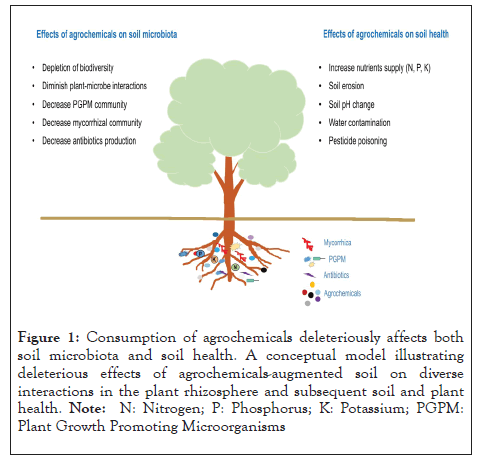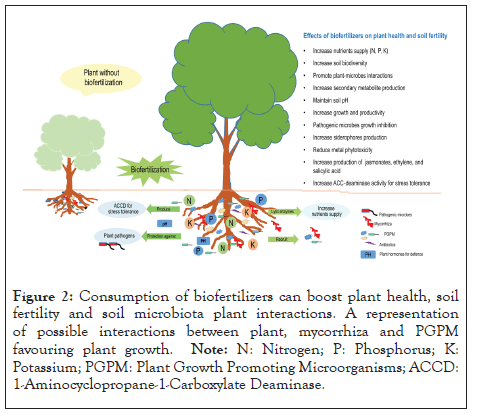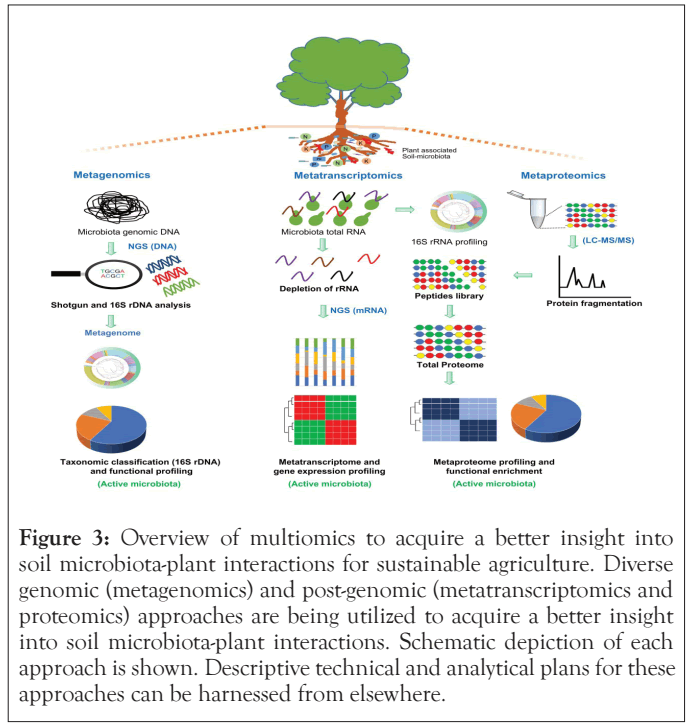Journal of Proteomics & Bioinformatics
Open Access
ISSN: 0974-276X
ISSN: 0974-276X
Original Research Article - (2022)Volume 15, Issue 9
Plants do not grow in isolation; they interact with diverse microorganisms in their habitat. The development of techniques to identify and quantify microbial diversity associated with plants contributes to our understanding of the complexity of environmental influences to which plants are exposed. Identifying interactions which are beneficial to plants can enable us to promote healthy growth with minimal application of agrochemicals. Increased knowledge of plant microbial diversity can be applied to meet the growing demand for bio fertilizers for use in organic agriculture. In this article, we highlight the beneficial effects of soil-micro biota and bio fertilizers on improving plant health and crop yield. We propose that a multiomics approach is appropriate to evaluate viability in the context of sustainable agriculture.
Microbial diversity, Soil microbiota-plant interactions, Sustainable agriculture; Multiomics approach
The Green revolution in the 1960s led to an increase in yield of crops with the application of agrochemicals such as chemical fertilizers, insecticides, fungicides and herbicides on most agricultural lands. One of the major challenges for the 21st century is shifting to environmentally sound and sustainable crop production. Enhanced production is necessary to provide sufficient food to meet the increased demand arising from population growth. Over application of agrochemicals in farming has led to severe consequences on the physio-chemical properties and microbiota of soil (Figure 1). In its natural habitat, almost every plant is colonized by a diversity of microbial species [1]. These microorganisms play a crucial role in both soil and plant health and positively effect plant growth and yield. Microbial species that have co-evolved with their hosts can also confer resistance to diseases [2]. For example, Arbuscular Mycorrhizal Fungi (AMF) and Plant Growth-Promoting Microorganisms (PGPM) are tolerant to a variety of stresses, such as abiotic stress- drought, excessive salinity in the soil and resistance to heavy metals, thus supporting good plant health even in stressful environments [3]. A recent report on biofertilizers, namely combinations of PGPM and AMF, highlights their significance as eco-friendly and cost- effective tools to boost both soil health and plant yield [4].

Figure 1: Consumption of agrochemicals deleteriously affects both soil microbiota and soil health. A conceptual model illustrating deleterious effects of agrochemicals-augmented soil on diverse interactions in the plant rhizosphere and subsequent soil and plant health. Note: N: Nitrogen; P: Phosphorus; K: Potassium; PGPM: Plant Growth Promoting Microorganisms.
Plant microorganisms equipped with degradation pathways and metabolic capabilities assist in efficient degradation of organic/ inorganic pollutants and thus reduce the phytotoxicity of such pollutants [5]. For example, root endophytes equipped with a metal resistance/sequestration system can efficiently decrease metal phytotoxicity [6]. Hence, development and application of bio-fertilizers can boost plant health and crop yield in stressful environmental conditions. Soil microorganisms contribute to this in a sustainable cycle of soil health, plant health and increased crop yield with no harmful impact on ecosystems. In this review article, we highlight the impact of soil microbiota on plant health and crop yield and how biofertilizers enhance soil microbiota resulting in improved crop yield. We propose that a multiomics approach is best suited to evaluate the benefits of microbial diversity and biofertilizers on soil and plant health and crop yield.
Excessive consumption of agrochemicals diminishes soil microbiota-plant interactions
Agrochemicals, including chemical fertilizer application, are currently necessary to enhance crop yield. Their excessive application reduces soil properties and soil microbiota-plant interactions as well as contributing to environmental pollution (Figure 1) [7-10].
Continuous use of chemical fertilizers increases nutrient availability in soil which can upset the natural balance between plants for food sources such as below-ground nutrients versus above-ground photosynthesis [11]. It has been reported that reduction in microbial diversity in a nutrient-rich soil with adequate water content was primarily due to the competition of flora for light sources [7,12]. Moreover, changes in soil pH by excessive consumption of chemical fertilizers (i.e., Ammonium sulfate) is less beneficial to microbial richness and diversity (Figure 1) when compared with organic fertilizers or manures, suggesting long-lasting harmful effects of chemical fertilizers [13].
In the long run, high-throughput sequencing and 13C footprinting demonstrated that consumption of conventional agrochemicals has reduced the reliance of microbes on plantderived carbon due to chemically induced stresses between plants and soil [14]. Previously, it has been indicated that the relationship between plants and soil microbiota could be altered by changing symbiotic relationships between plant and associated AMF [15]. In addition, consumption of N2-fertilizers can also affect the species richness and diversity of AMF by increasing nutrient levels in the soil, thus affecting their inter-relationship [16]. Consequently, the modulation in plant-microbe interactions induced by consumption of chemical fertilizers might also be related to the time duration of plant growth. Many studies of this impact on plant-microbe interactions have been carried out over short timescales [10,14,17-19]. Studies over longer time-periods are required to monitor soil microbiota and plant interaction where organic soil improvement has been applied. Organic methods of soil improvement and plant fertilization are being increasingly applied [20]. The use of nitrogen fixing bacteria in modern agricultural practices as a plant growth promoter has become an effective and eco-friendly strategy to cut down the need of conventional inorganic nitrogenous fertilizers [21].
Soil-microbiota- an ecological engineer
Population growth is a major challenge for humankind. How can we produce sufficient food in a sustainable way? Reliance on artificial, chemical fertilizer is incompatible with the need to develop sustainable agricultural practices which are equally focussed on maintaining soil health and improving crop productivity. For a growing population, conventional agricultural practices are unsustainable. Moreover, it is a challenging task for both farmers and policy makers to satisfy increasing food demand. On the other hand, over use of agrochemicals, i.e., pesticides, and chemical fertilizers have led to reduction in the microbial diversity in the soil and consequently reducing crop productivity [22]. To overcome these challenges the use of biofertilizers, Plant Growth Promoting Microorganisms (PGPM), and arbuscular mycorrhizal fungi offer a sustainable alternative (Table 1 and Figure 2) [23,24]. For example, microbes associated with seeds can significantly influence plant health by positively effecting seed germination and development, thus enhancing crop productivity [25]. Co-inoculation of mycorrhizae with plant growth promoting rhizobacteria ameliorates the negative effect of biotic stress and induces resistance against phytopathogens, through promoting growth attributes [4,26].
| Biofertilizer and their biochemical property | Enriched microorganism(s) |
|---|---|
| Nitrogen fixing | Rhizobium spp. and Frankia spp. |
| Phosphorus solubilising | Pseudomonas striata and Penicillium spp. |
| Zinc solubilising | Pseudomonas and Bacillus spp. |
| Sulphur oxidising | Acidothiobacillus spp., Xanthobacter and Pseudomonas spp. |
| Potassium mobilising | Aspergillus niger |
| Bacillus spp., | |
| Acidothiobacillus spp., Burkholderia spp., Ferrooxidans spp., Paenibacillusspp. and | |
| Pseudomonas spp. | |
| Other plant growth promoting microbes | Agrobacterium spp., Enterobacter spp., Streptomyces spp., Pseudomonas fluorescens and Xanthomonas spp. |
Table 1: Examples of recognised bio fertilizers, and their properties to empower sustainable agriculture.

Figure 2: Consumption of biofertilizers can boost plant health, soil fertility and soil microbiota plant interactions. A representation of possible interactions between plant, mycorrhiza and PGPM favouring plant growth. Note: N: Nitrogen; P: Phosphorus; K: Potassium; PGPM: Plant growth promoting microorganisms; ACCD: 1-Aminocyclopropane-1-Carboxylate Deaminase.
The PGPM boost plant growth and crop productivity
The PGPM has been considered an eco-friendly and cost-effective means to control plant pathogens by inducing defence responses, activating cellular components, cell wall reinforcement and production of secondary metabolites [27,28]. Plant hormones such as jasmonates, ethylene, and salicylic acid play a vital role in defence signalling [27,28], solubilizing phosphates and regulating the production of plant pathogens [29]. Moreover, rational dosages of distillery effluent assessed on the productivity of chickpea and on the augmented soil rhizobia (in clay pots) has demonstrated that irrigation water combined with a low concentration (100 m3 ha−1) of distillery effluent enhanced plant growth, improved soil biochemical properties as well as root-associated rhizobia [30]. The PGPM can directly facilitate plant-growth and development by positive regulatory mechanisms and processes (Table 1 and Figure 2). They aid nutritional uptake and enhance nutrient availability by solubilization of minerals, N2 fixation, and mineralization of organic compounds and production of several plant hormones [31]. Atmospheric N2-fixing PGPM inoculation rejuvenates growth-promoting activity, disease management and balances the N2 level in the plants [32,33]. Augmentation of phosphorus solubilizing microbes, Mesorhizobium ciceri and M. mediterraneum, isolated from chickpea nodules [34] could be used in biofertilizer formulations to enhance soil health. Several other PGPM that solubilize organic and inorganic soil metals could boost plant growth/yield. This in-built aptitude of PGPM has been recognized in bio-fertilizer formulations and could contribute to development of sustainable agricultural practices (Table 1). Also, employment of microbial antagonists to compete with plant pathogens have been suggested as more beneficial to plant and soil health than the application of chemical pesticides [35]. For example, PGPMs like Bacillus and Pseudomonas spp. inhibit the growth of harmful microbes by producing antibiotics (Table 1). Use of PGPM-antibiotics to combat several plant pathogens offers a promising prospect of biocontrol mechanisms as demonstrated by studies of PGPM-antibiotics for over two decades [35].
Mycorrhizal fungi boost plant growth and productivity
Mycorrhizae are the association between roots and fungi. This symbiotic relationship has been identified in about 90% of all land plants. A dramatically larger root web in association with mycorrhizae permits the plant to obtain additional moisture and nutrients (Figure 2). This is particularly important in uptake of phosphorus, one of the crucial nutrients for plant growth. A symbiotic relationship between plant and fungi can play a vital role in the tolerance of drought and salinity stress. An arbuscular mycorrhiza that modulates hormonal balance and thus the physiology of respective plants is an excellent example of such symbiotic relationships. The arbuscular mycorrhiza also improves the efficiency of photosystem II and photosynthetic products under low water conditions [36]. For example, Trichoderma harzianum promotes root growth even in water deficient conditions in rice crops [37,38].
Several studies on Medicago truncatula suggest mycorrhizal symbiosis has a more substantial impact on the plant microbiome. This is indicated by the mycorrhizal fungi contributing to formation of fungal mantle around the roots [39,40]. This fungal mantle enhances soil health and metabolites in the roots’ vicinity. Consequently, bacteria accumulate in the hyphal networks. Additionally, when mycorrhizae colonize roots of a plant this is known to provide a safeguard net against several plant diseases (Figure 2).
A relatively recent study on adaptation of plants in environmental fluctuations suggests that plants can adapt, interact, modify and select specific microbial communities to reduce harmful effects of different stresses, a phenomenon known as ‘Cry for Help’ [2,35]. Therefore, the adjustment of these interactions between plant and microbes could represent a positive option to mitigate adverse effects of climate change on food crops. In this framework, microbiome engineering has recently emerged as a promising approach in order to promote positive interactions between soil microbiota and cognate host-plant.
The rise of omics approaches enables the investigation of microbial diversity and plant-microbe interactions across diverse ecological communities (Figure 3). Integrated multiomic approaches are revealing the composition of microbiomes [31]. Scientific advancements, especially genome sequencing can help to characterize valuable features for both plant and associated soil microbiota. For example, genome sequencing of a number of endophytic bacteria, microbes which colonize plant tissues, has brought insight in several ingrained beneficial traits, such as N2 fixation, quorum sensing, biofilm formation, iron uptake and metabolism. This suggests endophytic bacterial life style is well-equipped to survive in an iron-limiting environment and can competently sequester iron (when needed) from other microbes, including from plant-pathogens [21].

Figure 3: Overview of multiomics to acquire a better insight into soil microbiota-plant interactions for sustainable agriculture. Diverse genomic (metagenomics) and post-genomic (metatranscriptomics and proteomics) approaches are being utilized to acquire a better insight into soil microbiota-plant interactions. Schematic depiction of each approach is shown. Descriptive technical and analytical plans for these approaches can be harnessed from elsewhere.
Likewise, genome analysis of diazotrophic K. pneumonia bacterium displays its aptitude to tackle harmful plant reactive oxygen species by expressing a number of defensive enzymes, such as superoxide dismutases, putative catalases, peroxidases and reductases etc.
A metagenomic analysis of endophytic bacteria, from rice crops, demonstrated several key features that are shared among endophytes which are crucial for establishing successful plant-microbe interactions. By employing post genomic approaches, for example: metatranscriptomics, i.e. global expression analysis of mRNA: metaproteomics, i.e. global expression analysis of proteins and metaproteogenomics (Figure 3), a deeper insight into plant-endophyte interactions can be harnessed by linking up the genomic information with physiological attributes of plants. A metaproteogenomic study on the microbial communities of rice phyllosphere and rhizosphere demonstrated that despite the presence of nifH genes in both micro-environments, dinitrogenase reductase was exclusively identified in the rhizosphere [39]. If such approaches could be employed to study the endosphere of other plants or crops, along with synthetic, biology enabled microbiome engineering, significant exploration in the soil microbiota-plant interactions would be feasible to promote more sustainable agricultural methods through application of biofertilizers.
Many unanswered questions remain within the field of soil microbiota-plant interactions. An understanding of the role of plant microbe interactions to the agricultural systems is necessary to manage the soil microbiota to achieve maximum benefit of plant and soil health, i.e. sustainable agriculture. Exploring these interactions can help to devise strategies to harness their full potential. Unravelling molecular complexity can make a valuable contribution to operationalize these interactions which will result in improved soil health, good plant health and sustainable crop yields, all of which are essential if the increasing world population is to be fed.
The authors declare no conflict of interest.
We acknowledge David Johnstone for critical reading and improving English of the manuscript. DKG also acknowledges Umea University, Sweden for its learning environment and development opportunities for young researchers.
DKG and UK proposed the concept and written initial drafts of the manuscript. DKG, UK and KKK improved and approved the manuscript.
[Crossref] [Google Scholar] [PubMed]
[Crossref] [Google Scholar] [PubMed]
[Crossref] [Google Scholar] [PubMed]
[Crossref] [Google Scholar] [PubMed]
[Crossref] [Google Scholar] [PubMed]
[Crossref] [Google Scholar] [PubMed]
[Crossref] [Google Scholar] [PubMed]
[Crossref] [Google Scholar] [PubMed]
[Crossref] [Google Scholar] [PubMed]
[Crossref] [Google Scholar] [PubMed]
[Crossref] [Google Scholar] [PubMed]
[Crossref] [Google Scholar] [PubMed]
[Crossref] [Google Scholar] [PubMed]
[Crossref] [Google Scholar] [PubMed]
[Crossref] [Google Scholar] [PubMed]
[Crossref] [Google Scholar] [PubMed]
[Crossref] [Google Scholar] [PubMed]
[Crossref] [Google Scholar] [PubMed]
[Crossref] [Google Scholar] [PubMed]
[Crossref] [Google Scholar] [PubMed]
[Crossref] [Google Scholar] [PubMed]
[Crossref] [Google Scholar] [PubMed]
[Crossref] [Google Scholar] [PubMed]
[Crossref] [Google Scholar] [PubMed]
[Crossref] [Google Scholar] [PubMed]
[Crossref] [Google Scholar] [PubMed]
Citation: Gahlot DK, Kumar U, Kapoor KK (2022) Plant-Microbe Interactions: Existing Awareness and Recommendations for Sustainable Agriculture. J Proteomics Bioinform. 15:605.
Received: 09-Sep-2022, Manuscript No. JPB-22-19077; Editor assigned: 13-Sep-2022, Pre QC No. JPB-22-19077 (PQ); Reviewed: 27-Sep-2022, QC No. JPB-22-19077; Revised: 04-Oct-2022, Manuscript No. JPB-22-19077 (R); Published: 11-Oct-2022 , DOI: 10.35248/0974-276X.22.15.605
Copyright: © 2022 Gahlot DK, et al. This is an open access article distributed under the terms of the Creative Commons Attribution License, which permits unrestricted use, distribution, and reproduction in any medium, provided the original author and source are credited.